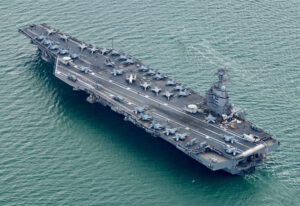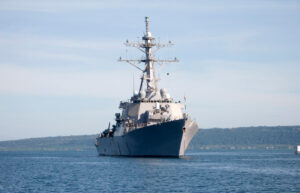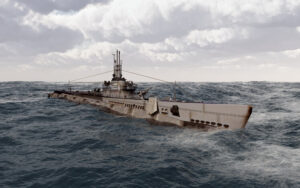Asbestos on Navy Ships
The United States Navy used more asbestos-containing materials than any other military branch. As a result, U.S. Navy veterans are at the highest risk of developing lung cancer, mesothelioma, and other asbestos-related diseases. Those diagnosed with an asbestos-related illness may be eligible for compensation and U.S. Department of Veterans Affairs (VA) benefits.
Asbestos Exposure on Navy Ships
 From the early 1930s to the 1980s, every naval vessel used asbestos in its construction. Asbestos is lightweight, inexpensive, and well-suited for fireproofing and insulation, making it the perfect material for naval ships. Sadly, asbestos also came with incredibly harmful health impacts.
From the early 1930s to the 1980s, every naval vessel used asbestos in its construction. Asbestos is lightweight, inexpensive, and well-suited for fireproofing and insulation, making it the perfect material for naval ships. Sadly, asbestos also came with incredibly harmful health impacts.
When the material is disturbed, microscopic asbestos fibers break off and contaminate the air. Due to the poor air circulation on naval vessels, service members were at high risk of inhaling the fibers. Inhaled asbestos fibers can remain in the body for decades and lead to aggressive diseases like lung cancer and mesothelioma.
Fortunately, veterans diagnosed with lung cancer or mesothelioma after serving on a Navy ship can pursue VA benefits such as medical care and monthly payments. Navy veterans and their loved ones may also qualify for legal compensation after an asbestos-related diagnosis. Get a free case review today to see if you are eligible.
- Access Financial Aid and Justice
- Learn About Your Options
- Contact Us for Free

Symptoms of Asbestos Exposure
Asbestos exposure is sometimes considered a hidden danger. Symptoms of asbestos-related diseases may not become apparent until decades after someone was first exposed.
By the time symptoms of lung cancer, mesothelioma, and other asbestos-related illnesses become worrisome, the patient may already be in the advanced stages of the disease.
- Chest pain or tightness
- Cough that does not improve
- Fatigue
- Loss of appetite
- Shortness of breath
If you are experiencing these symptoms and were exposed to asbestos on Navy ships, contact your health care provider immediately.
You may also want to note if you worked with or around asbestos or have a history of smoking. Your doctor can then recommend screenings for lung cancer or mesothelioma.
How Was Asbestos Used on Different Types of Navy Ships?
Asbestos-containing products were used in almost every part of naval vessels built between the 1930s and 1980s. Gaskets, engines, insulation, and even flooring all contained asbestos, putting service members at risk on a daily basis. Learn how asbestos was used aboard different types of U.S. Navy ships below
Aircraft Carriers
 Aircraft carriers are considered one of the most important vessels in the U.S. Navy. Serving as an airbase at sea, carriers can transport dozens of aircraft. Aircraft carriers built between the 1930s and 1980s contained tons of asbestos.
Aircraft carriers are considered one of the most important vessels in the U.S. Navy. Serving as an airbase at sea, carriers can transport dozens of aircraft. Aircraft carriers built between the 1930s and 1980s contained tons of asbestos.
Because of its fireproofing abilities, asbestos was a coveted material on aircraft carriers. Asbestos reduced fires and protected expensive cargo. Additionally, the material was used on flight decks and on the aircraft themselves for insulation and fireproofing.
Some aircraft carriers contained nearly 1,000 tons of asbestos.
Battleships
During World War II, battleships were at the core of the U.S. Navy’s brigade. These large vessels were used to take down enemy ships.
They were also frequent targets of enemy fire. Because of this, these ships used asbestos heavily to protect them from fire, water damage, and electrical damage. Additionally, engine rooms, boiler rooms, and gunner turrets in battleships used asbestos-based soundproofing, thermal insulation, and more.
Cruisers
Considered some of the most versatile ships in the Navy, cruisers were designed for fast movement — even across long distances. Throughout the 20th century, every cruiser built contained asbestos.
Almost every part of the ship contained asbestos, from protective paneling and fireproofing to paint and deck tiles.
Destroyers
 Any Navy destroyer built before the 1980s contained asbestos to fireproof, insulate, and coat electrical wires so they could withstand electrical damage and fire from incoming attacks. The lightweight material allowed destroyers to move quickly and travel long distances.
Any Navy destroyer built before the 1980s contained asbestos to fireproof, insulate, and coat electrical wires so they could withstand electrical damage and fire from incoming attacks. The lightweight material allowed destroyers to move quickly and travel long distances.
However, Navy personnel stationed on destroyers that used asbestos were in danger of exposure and developing serious illnesses later in life.
Frigates
Smaller than destroyers, frigates were used to accompany transport ships and perform small-scale attack duties. Since frigates were used mainly as support ships, many Navy personnel lived and worked on board.
As in other types of Navy ships, asbestos was used throughout virtually all frigates prior to the 1980s. Asbestos could be found in flooring and ceiling materials as well as the insulation that coated miles of piping throughout the ship.
Minesweepers
Minesweepers led the charge of many naval missions to create safe routes for other Navy ships. These ships were equipped with technology to detect and destroy naval mines. Minesweepers required extensive use of asbestos to protect their equipment and crew from explosive damage.
At least 300 minesweepers are known to have used asbestos-containing products, putting those who served aboard them at risk of developing asbestos-related lung cancer or mesothelioma later in life.
Submarines
 Critical for underwater missions, submarines were used as both offensive tactical ships and for intelligence gathering. Submarines required extensive asbestos insulation and waterproofing to keep them safe underwater. Thus, submarines built before the 1980s used tons of asbestos.
Critical for underwater missions, submarines were used as both offensive tactical ships and for intelligence gathering. Submarines required extensive asbestos insulation and waterproofing to keep them safe underwater. Thus, submarines built before the 1980s used tons of asbestos.
Because of poor airflow, especially when submerged for long periods, many Navy veterans stationed on submarines that used asbestos are now at tremendous risk of developing harmful illnesses.
Other Navy Ships
Many other Navy ship types used asbestos widely for various purposes. Service members working on these ships were put in danger of asbestos exposure and the diseases linked with it.
Other Navy ship types that used asbestos included:
- Ammunition and explosive freighters
- Amphibious ships
- Auxiliary ships
- Escort ships
- Hospital vessels
- Merchant or other transport ships
- Oilers and tankers
Makers of asbestos-based products put millions of people at risk of serious illness even though they knew the potential dangers of this toxic substance as far back as the 1930s.
Thankfully, Navy veterans and their family members can find support through VA benefits and other financial compensation options. Contact the Lung Cancer Group team to see if you’re eligible.
Navy Occupations at High Risk
The widespread use of asbestos on ships put virtually every Navy position at high risk of exposure. However, some Navy Military Occupational Specialties (MOSs) were at an even greater risk because of their location on the naval vessel and the type of work they performed daily.
Navy occupations at high risk of asbestos exposure included:
- Boilermen and boiler technicians
- Electricians
- Enginemen and engine room mechanics
- Firefighters
- Gas turbine system technicians
- Gunners and gunnery technicians
- Hull technicians
- Machinist’s mates
- Pipefitters
- Shipbuilders and shipyard workers like laggers
- Shipfitters and steamfitters
- Submarine engineers
- Welders
Asbestos Use in Navy Shipyards
Because every U.S. Navy ship built between the 1930s and 1980s contained extensive amounts of asbestos, shipbuilders and shipyard workers were also put at high risk of exposure every day.
More than 100 shipyards across 11 states throughout the nation used asbestos.
Shipyard workers performed labor-intensive work directly with asbestos materials, making it incredibly likely for them to inhale the microscopic fibers.
Even those who lived near Navy shipyards at the time asbestos was in high use might have been at risk of exposure. This is due to the likelihood of asbestos fibers breaking off from construction materials and remaining in the air.
Financial Help for Navy Veterans Exposed to Asbestos on Ships
Navy veterans served their country selflessly and potentially sacrificed their health even after serving because of asbestos exposure on Navy ships.
Thankfully, there are resources available to support veterans who may have developed lung cancer or mesothelioma after being exposed to asbestos.
Resources for eligible veterans exposed to asbestos include:
- Compensation for surviving family members
- Legal help to pursue lawsuits and settlements
- VA benefits, including disability compensation
These financial resources can help pay for lung cancer and mesothelioma treatments, health care costs, and other expenses.
We can help connect you with a VA-accredited asbestos attorney who can help you file a VA claim or asbestos lawsuit. Call us now at (877) 446-5767.
FAQs About Asbestos on Navy Ships
When was asbestos banned on ships?
The use of asbestos was widespread between the 1930s and early 1980s. Every Navy vessel used the material until studies began showing the health risks of asbestos.
The Navy stopped using asbestos to build new ships in 1978, according to documents from the U.S. Comptroller General of the United States. By the 1980s, the U.S. Navy began removing asbestos-containing materials from its vessels.
Is asbestos still used on Navy ships?
Even though the U.S. Navy no longer uses asbestos in shipbuilding, there are still some ships that may be contaminated with the harmful material.
Because asbestos was used extensively on Navy ships, it was difficult to fully remove all traces safely. As long as the asbestos-containing products are not damaged or disturbed, they don’t pose a threat.
Can I receive VA disability for asbestos exposure on ships?
Yes, possibly. Veterans who were exposed to asbestos and developed lung cancer, mesothelioma, or another asbestos-related disease may be eligible for VA benefits, including VA disability compensation.
The VA often categorizes lung cancer and mesothelioma diagnoses at a 100% disability rating. This means affected veterans are eligible for the highest financial payouts and lowest health care premiums.
Can veterans pursue legal claims for asbestos exposure?
Yes. Those exposed to asbestos who later developed lung cancer or mesothelioma may be eligible for compensation through legal claims. These funds can help pay for treatment, suport surviving family members, and cover other costs.
Pursuing a lawsuit or asbestos trust fund claim won’t affect your ability to file for VA benefits. Additionally, most lawsuits are filed against asbestos manufacturers, not the military or U.S. government. Veterans made a tremendous sacrifice in serving our country. They should not have to navigate life after a lung cancer or mesothelioma diagnosis alone.
The patient advocates at Lung Cancer Group can help connect you with an experienced asbestos law firm. Request a free case review to get started.

